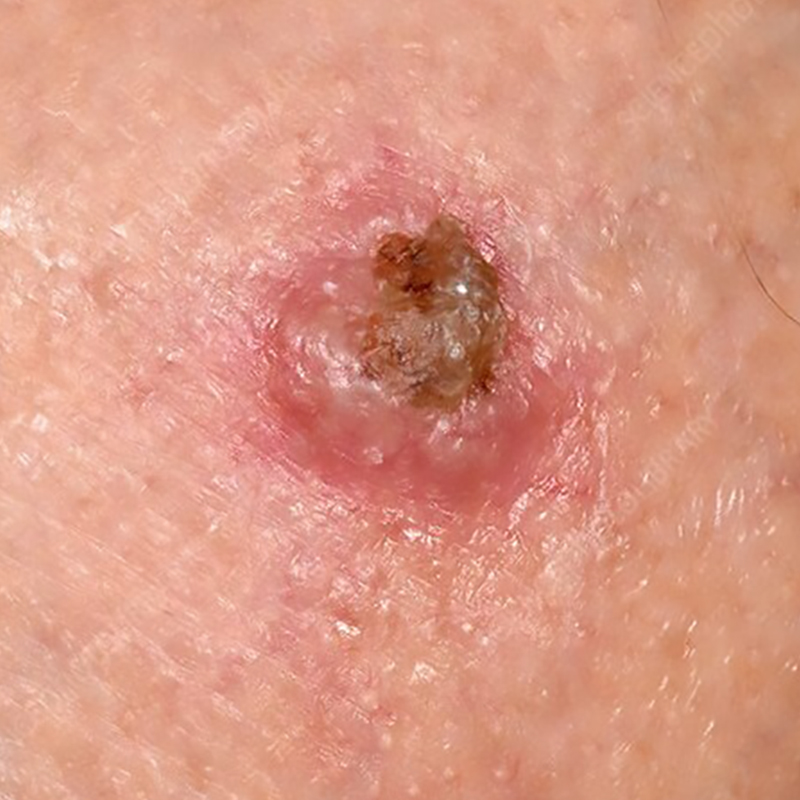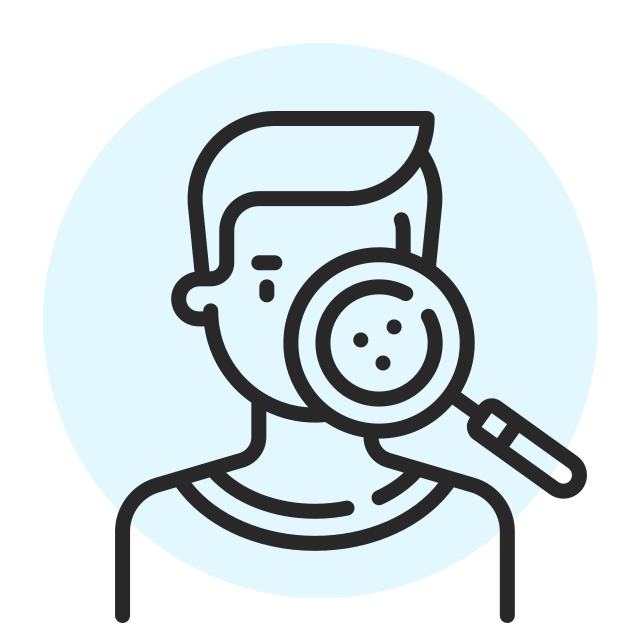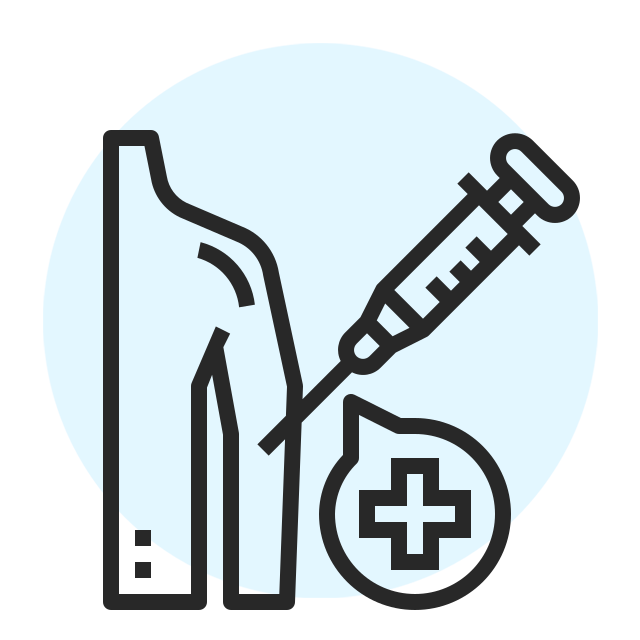
Squamous Cell Carcinoma (SCC)
Squamous cell carcinoma (SCC) is a type of cancer found in the middle layers of the skin (squamous layers). This happens when cells begin dividing uncontrollably, creating tumors and can possibly spread. SCC can appear anywhere on the body, but most commonly in sun exposed areas, and can become life-threatening if left untreated.

- UV light: Overexposure to ultraviolet radiation from sunlight or tanning beds.
- Genetics: Family history of skin cancer.
- Fair Skin: Having fairer skin reduces your protection from UV light.
- Weak immune system: Illnesses and immunosuppressive medications can weaken your immune system and prevent it from fighting off the SCC.
- Age/Sex: Being older will increase your chance of developing SCC, and men develop SCC at a higher rate than women.

- UV light: Overexposure to ultraviolet radiation from sunlight or tanning beds.
- Genetics: Family history of skin cancer.
- Fair Skin: Having fairer skin reduces your protection from UV light.
- Weak immune system: Illnesses and immunosuppressive medications can weaken your immune system and prevent it from fighting off the SCC.
- Age/Sex: Being older will increase your chance of developing SCC, and men develop SCC at a higher rate than women.

- Avoid prolonged exposure under sunlight between 10 a.m. to 4 p.m., wear sunscreen at least SPF 50
- Wear protective clothing covering the arms and legs, broad-brimmed hat.
- Avoid tanning beds.
- Examine your skin often.
- Blackheads: Small black bumps on the surface of the skin made of oil and dead skin cells.
- Whiteheads: Are like blackheads except they are closed off at the top and look like a white bump.
- Pimples: Are blemishes, more often red and white, and are typically inflamed. Pimples will also often have pus at their tips.
- Nodules: Much larger and look like large lumps under the skin.

- Avoid prolonged exposure under sunlight between 10 a.m. to 4 p.m., wear sunscreen at least SPF 50
- Wear protective clothing covering the arms and legs, broad-brimmed hat.
- Avoid tanning beds.
- Examine your skin often.
- Blackheads: Small black bumps on the surface of the skin made of oil and dead skin cells.
- Whiteheads: Are like blackheads except they are closed off at the top and look like a white bump.
- Pimples: Are blemishes, more often red and white, and are typically inflamed. Pimples will also often have pus at their tips.
- Nodules: Much larger and look like large lumps under the skin.

SCC can progress in many ways and generally present as a small, red nodule or bump on an area of skin commonly exposed to sunlight. It can also present as a scaly patch of skin; a sore; or a crusty patch of skin.
The lesions can develop into an ulcer and refused to heal or when it heals over, it continually breaks down again. Typically SCC will spread locally, getting larger with time. However, there is a small chance that SCCs can spread to other areas of the body.

SCC can progress in many ways and generally present as a small, red nodule or bump on an area of skin commonly exposed to sunlight. It can also present as a scaly patch of skin; a sore; or a crusty patch of skin.
The lesions can develop into an ulcer and refused to heal or when it heals over, it continually breaks down again. Typically SCC will spread locally, getting larger with time. However, there is a small chance that SCCs can spread to other areas of the body.

If you believe you have an SCC, your physician will first inspect the lesion and ask you about your health history. If your lesion is suspected to be a skin cancer, your physician may:
- chose to closely monitor the lesion to see if it progresses with time
- perform a biopsy, take a small piece of the skin lesions, and send it to the lab to confirm the diagnosis
- refer you to a specialist who have the equipment to inspect the lesions further. For example, you may be referred to a dermatologist who would look at the lesion with a dermatoscope, a special skin microscope, to include or exclude the diagnosis.

If you believe you have an SCC, your physician will first inspect the lesion and ask you about your health history. If your lesion is suspected to be a skin cancer, your physician may:
- chose to closely monitor the lesion to see if it progresses with time
- perform a biopsy, take a small piece of the skin lesions, and send it to the lab to confirm the diagnosis
- refer you to a specialist who have the equipment to inspect the lesions further. For example, you may be referred to a dermatologist who would look at the lesion with a dermatoscope, a special skin microscope, to include or exclude the diagnosis.

Early stages (Not yet spread)
- Excision: surgically removing the cancer is the most definitive and common way for treating early staged SCCs. A physician will attempt to cut out the entire tumor, along with a healthy skin margin to ensure that the entire cancerous tissue is removed. The excised tumor is then sent to a lab to confirm that the entire tumor is removed.
- Cryosurgery: using liquid nitrogen to freeze and destroy the cancer cells.
- Radiation therapy uses high-energy beams, such as X-rays and protons to kill the cancer cells.
- Topical medications: 5-FU (a topical chemotherapy) or imiquimod (a topical immunotherapy) can be applied on the affected area to directly attack the cancerous cells.
Late Stages (Spread to other parts of the body)
- Targeted therapy: drugs that target specific molecules on or inside cancerous cells to prevent growth or division of the cancer
- Chemotherapy: The use of strong drugs and chemicals that target and kill cancerous cells in your body.
- Immunotherapy: A type of biological therapy that helps boosts the immune system signals and enable your own immune system to fight off the tumors and destroy cancerous cells in your body

Early stages (Not yet spread)
- Excision: surgically removing the cancer is the most definitive and common way for treating early staged SCCs. A physician will attempt to cut out the entire tumor, along with a healthy skin margin to ensure that the entire cancerous tissue is removed. The excised tumor is then sent to a lab to confirm that the entire tumor is removed.
- Cryosurgery: using liquid nitrogen to freeze and destroy the cancer cells.
- Radiation therapy uses high-energy beams, such as X-rays and protons to kill the cancer cells.
- Topical medications: 5-FU (a topical chemotherapy) or imiquimod (a topical immunotherapy) can be applied on the affected area to directly attack the cancerous cells.
Late Stages (Spread to other parts of the body)
- Targeted therapy: drugs that target specific molecules on or inside cancerous cells to prevent growth or division of the cancer
- Chemotherapy: The use of strong drugs and chemicals that target and kill cancerous cells in your body.
- Immunotherapy: A type of biological therapy that helps boosts the immune system signals and enable your own immune system to fight off the tumors and destroy cancerous cells in your body